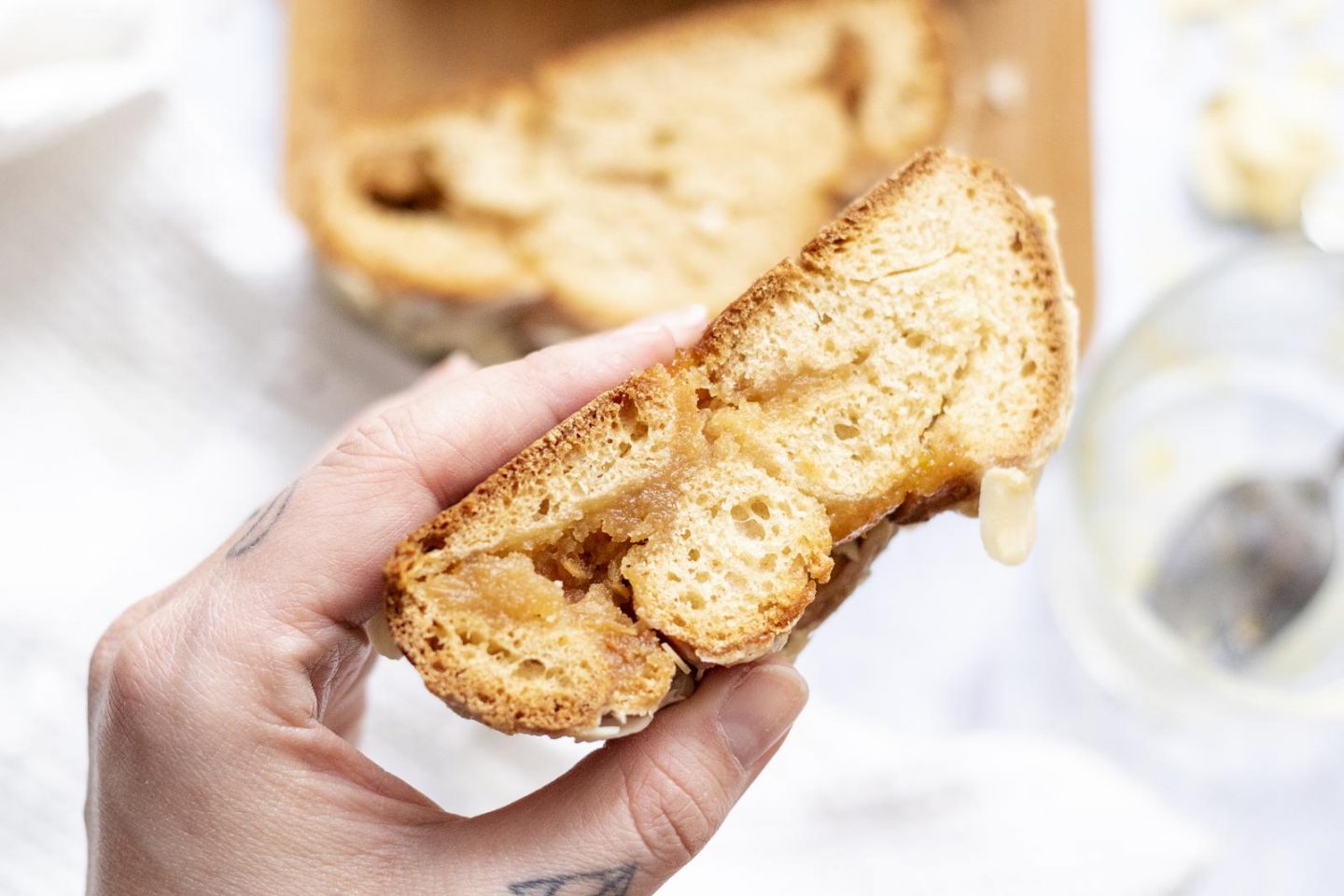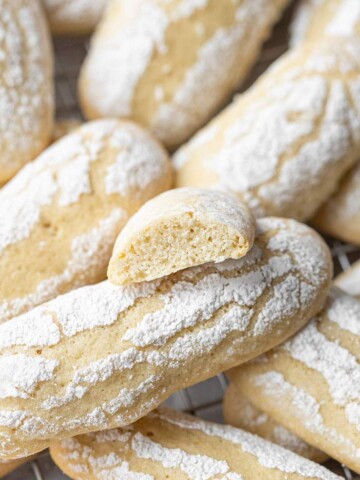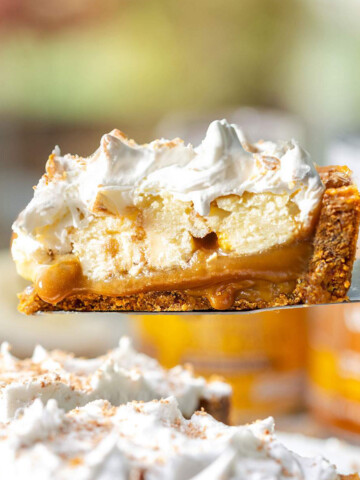Create this deliciously fluffy Vegan Easter Plait with this easy-to-follow recipe - using Aquafaba to create a soft and more-ish texture!

Vegan Easter Plait Recipe
My first ever recipe for a Vegan Easter Plait! And wow - I'm actually so happy with how it turned out! Like with everything, I don't have too many expectations of getting a great result when trying something for the very first time. Instead, I consider it to be part of the learning process to gain knowledge and experience with new techniques and recipes.
But what a lucky surprise in this case! And it's not actually just my first ever Vegan Easter Plait - but also the first-ever plait I've created.
Filled with marzipan cream, toasted almonds, and brushed with marmalade, this vegan easter plait has turned out perfectly fluffy and soft on the inside with a deliciously sweet crunch on the outside. If you've ever tried an Easter plait - or also a wreath - you might know of its distinctive soft texture and how perfectly fluffy it pulls apart. Creating this kind of texture in a vegan version is, of course, a little trickier than the non-vegan equivalent (which is containing a lot of eggs!).
Ingredients for this recipe:
For the dough:
- 2 teaspoon Dried Active Yeast
- 250ml lukewarm soy milk
- 75g melted butter
- 75g raw organic sugar
- 3 tablespoon Aquafaba (frothed chickpea water)
- ½ teaspoon salt
- 500g plain flour
For the marzipan filling:
- 300g marzipan
- 100g chopped almonds or almond flakes
- 5 tablespoon Aquafaba
- Juice of 1 lemon
For the coating:
- 1 tablespoon marmalade (apricot, orange or mandarin) (optional)
- 1 tablespoon water

How to make a Vegan Easter Plait
In this vegan version, I have used Aquafaba to replace the eggs. And even if you've never used Aquafaba before, let me give you a quick rundown of how to create it yourself in mere minutes.
How to use Aquafaba:
- Pour the water of 1 chickpea can into a bowl (set the chickpeas aside for later!).
- Using a hand blender froth up the chickpea water at high speed for about 10 minutes or until it's perfectly fluffy and maintaining its shape.
- Depending on the recipe you'd add in sugar at this point, but as the Aquafaba will be added to the rest of the sweet recipe ingredients, this is not necessary in this case
For this recipe, you will need the Aquafaba created from 1 tin of chickpeas.
As you will see from the recipe steps below, the dough needs to proof for an hour in the preparation process. This proving time is very important to create a fluffy texture and to ensure the plait grows in the oven. Ensure that you don't overproof the plait either - otherwise, it can become hard in the baking process. So, as you might be able to tell - hitting the right proofing time is key!
To proof the dough I usually place it in a greased bowl on my stove (with the stove off!) - coconut oil is great on this occasion - as my kitchen is pretty warm at all times. Ideally, you should cover up the bowl, I'd recommend using a clean damp kitchen towel to cover and let the dough do its thing underneath. It's also the perfect time for you to create the marzipan filling. This is pretty straightforward: crumble your marzipan into a bowl, add the juice of 1 lemon and about 5 tablespoon of the Aquafaba and gently whisk it up until you have a smooth Marzipan paste. You can alternatively use a small blender or food processor to help you with this process.
To prepare your almonds for the filling, simply toast them in a frying pan without oil until golden (be careful not to burn them!) and set them aside. You can also toast them in the oven until golden, but make sure to keep a close eye on them as they burn very easily.
The tricky part of creating this recipe was the arranging of the plait for me - considering I had never done it before! But I have confidence that you can do it too - after all, I managed on the first attempt!
How to shape the Easter Plait:
- Once your dough has proven for an hour, roll it out to a rectangular shape, spread the Marzipan mass on the top (leaving about 5 spoonfuls in the bowl for later), sprinkle the toasted almonds on the top and then start rolling up the dough into a log, starting on the long edge of the rectangular.
- Use a sharp knife to cut the plait in half lengthwise - leaving about 2-3 cm connected at the top.
- Cutting the log will display the layers we've created by rolling the dough - keeping these layers visible on the top, carefully twist the two halves and press the dough together at the bottom.
I would recommend rolling out the dough on a lightly floured baking sheet straight on the baking tray as it will be difficult to transfer it to a different surface once it's rolled, cut, and plaited.
Place your plait in the oven for about 25 minutes, then brush the remaining marzipan cream on the outer parts of the plait, sprinkle some more almonds on and place it back in the oven for another 10 minutes. After the baking time elapses, remove the plait from the oven and brush the inside parts of the plait with marmalade (I've used Sicilian Mandarin Conserve!).
I honestly hope you'll enjoy creating this recipe for your family and friends this Easter!

This recipe is:
- Vegan
- Dairy-Free
- Egg Free
- Fluffy and Soft
- Super Sweet
- Big enough to cater for a family of 4-6
- Using Aquafaba as egg replacement
- Simple to re-create
You might also enjoy these recipes:
📌 If you love Pinterest you can pin any of the images to your boards!
📖 Recipe Card

Vegan Easter Plait with Marzipan
Ingredients
For the dough:
- 2 teaspoon Dried Active Yeast
- 250 ml lukewarm soy milk
- 75 g melted butter
- 75 g raw organic sugar
- 3 tablespoon Aquafaba frothed chickpea water
- ½ teaspoon salt
- 500 g plain flour
For the marzipan filling:
- 300 g marzipan
- 100 g chopped almonds or almond flakes
- 5 tablespoon Aquafaba
- Juice of 1 lemon
For the coating:
- 1 tablespoon marmalade apricot, orange or mandarin (optional)
- 1 tablespoon water
Instructions
- Add the yeast to a large bowl alongside the sugar and about 3-4 tablespoon of the lukewarm soy milk, gently stir and set aside for about 10 minutes.
- In the meantime melt the butter and combine it with the remainder of the soy milk, 3 tablespoon of Aquafaba and salt, then pour in the yeast mixture before gradually adding the flour.
- Combine the dough with a spatula or wooden spoon and continue to knead the dough by hand on a floured surface once it becomes to dense to mix in the bowl.
- After about 5 minutes of kneading, place the dough in a greased bowl, cover with a cloth and leave it to rise in a warm location for about an hour. Within this time the dough should double in size.
- Whilst the dough is proving you can prepare the filling: Start by breaking up the marzipan into small chunks and adding it to a bowl. Pour in the Aquafaba and lemon juice and use a whisk or fork to blend until the marzipan has broken down and you have a smooth paste.
- Toast the almonds in a pan without oil until golden and set aside.
- After the hour has elapsed roll out the dough into a rectangular of about 2cm thickness. Spread most of the marzipan mass onto the top, leaving about 3 tablespoon for later. Sprinkle the toasted almonds over the top.
- Start on the longer edge of the rectangular and gently roll up the dough, finishing with the edge on the bottom size. Place the roll on a non-stick baking sheet.
- Using a knife, cut the roll along the long middle, leaving about 3 cm uncut at the top.
- Plait the 2 ends making sure the cut layers remain on the top. Once you get to the end, gently press the dough ends together to finish off the plait.
- Place the plait in the oven for about 25 minutes, check on the plait and brush it with the remaining marzipan mixture. Sprinkle more almond flakes across the top (optional) and place it back in the fridge for another 5-10 minutes.
- Remove the plait from the oven. In a small har mix the marmalade with a little bit of water and brush it across the plait. Let it cool down almost entirely before attempting to cut the plait.
- Serve on its own or with yoghurt, ice cream, whipped cream and co!
- Enjoy!

If you love baking, then how about you try giving these recipes a go:
*Disclosure: This page may contain affiliate links and sponsored links that earn me a small commission, at no additional cost to you. You can find more information in my Privacy Policy.
© 2025 Romy London / Romina Callwitz | All images, videos, wordings and content are copyright protected and belong to Romina Callwitz. Please do not use any of my content without prior permission. If you wish to re-publish any (part of my) content, please get in touch via email. Thanks for your support!
*Disclosure: This page may contain affiliate links and sponsored links that earn me a small commission, at no additional cost to you. You can find more information in my Privacy Policy.









💭 Leave a Comment